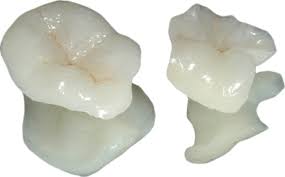What is the difference between an inlay and a filling?
 |
| Emax onlays |
In 2007 I wrote a post about inlays and it probably is time for another post on this topic. Inlays and their cousin, onlays , are restorations that are fabricated indirectly(usually) and then cemented or bonded into a patients tooth. direct composites and amalgams are placed into the filling directly. Fillings are the more affordable restoration but when they are large they may not be the most optimal way to restore a tooth.
Presently direct composite restorations are the dominant type of filling used for patients. These usually involve placing uncured composite directly into a restoration and setting it with a bonding light. The curing always causes some shrinkage (1.5-3 %) and this shrinkage can cause problems, especially for the restoration of larger cavity preparations. Also it can be difficult to achieve "tight" interproximal contacts when restoring some large fillings.
Using a proper technique direct fillings can be a long lasting and trouble free restoration for teeth that can last 10-30 years or more. Currently, when I place a composite filling I usually first coat much of the internal walls of the preparation with a flowable composite and set it with my curing light prior to adding small beads of composite to the internal of the preparation. By doing this , it is hoped that this shrinkage will be more directed and the resulting filling will be better fitting with less shrinkage stress placed on the walls of the preparation. This technique can be used with care to restore large preparations with good results much of the time. That being said, having a large filling prepared indirectly ( assuming a good preparation and impressioning) can produce a more predictably excellent result.
Inlays or onlays restoration covers one or more of a tooth's cusps) can be made out of a variety of materials including empress(porcelain), Emax (lithium disilicate) and composite materials. Gold was often used in the past but has fallen out of favor (due to it;s compromised esthetics and its higher cost). In my experience my most long lasting results were achieved using composite materials for fabrication of inlays or onlays. The other choices seem more prone to fracture probably because they were less flexible and more brittle.
Now a days many of these restorations are made using 21rst century technology that employs optical scanning and cad cam milling of the restorations. These computer generated restorations can provide excellent fitting restorations that are less expensive than the gold inlays we dentists used to make and are better looking as well. Some laboratories prefer "pressable" materials used with stone models since they do not require an investment in digital equipment and they maintain that these "analogue" inlays are better fitting and more durable. They may have a valid point, but clearly it seems that the more digital versions are becoming the industry standard.
Although many inlays and onlays are excellent restorations, they do require a skillful preparation and proper insertion technique for optimum success. In my opinion the biggest factor in ensuring success of restoration, whether we are referring to a crown, an inlay or a direct filling, is the skill and technique of the operator and his assistant. Sometimes how a restoration is done is more important than which type of restoration is employed.
from Ask Dr. Spindel - http://lspindelnycdds.blogspot.com/2020/11/what-is-difference-between-inlay-and.html - http://lspindelnycdds.blogspot.com/

Comments
Post a Comment